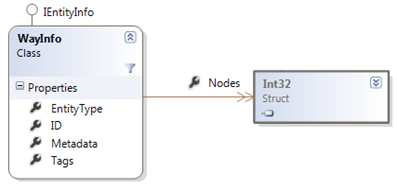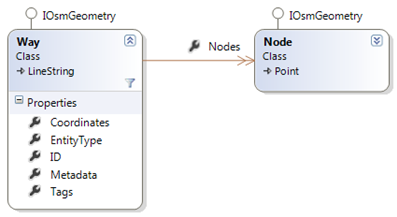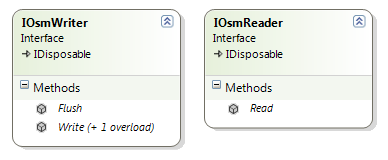Filtering OSM data with SpatialLITE
I'm a big fan of the OpenStreetMap project, so when I released the first version of the SpatialLITE library last week, classes for working with OpenSteetMap data couldn't be missing in the project. Right now the library supports OSM XML files (without compression) and OSM PBF files, both for reading as well as writing. And how can you work with OSM data? How does SpatialLITE library compare with other tools in terms of speed? Let's find out
... err wait, some introduction might be neccessary ...
IEntityInfo vs. IOsmGeometry
There are two different representation of the OSM entities in the library - IEntityInfo and IOsmGeometry objects.
IEntityInfo represents a lightweight object that contains only data for the particular entity - relationships with other entities are described only by IDs of related entities.

On the other hand a collection of IOsmGeometry objects represents tree of interconnected objects that implement IGeometry interface. This allows you to access properties of related entities directly, perform spatial analysis with methods from SpatialLite.Core library or use any other methods from the library that accepts IGeometry parameters. IOsmGeometry objects are pretty powerful, but the price is obvious - all objects must be held in the memory, and with large files it might easily become OutOfMemoryException kind of problem.

Tag signalsTag = new Tag("highway", "traffic-signals");
IEnumerable waysWithSignals = ways.Where(w => w.Nodes.Any(n => n.Tags.Contains(signalsTag)));
The decision whether use IEntityInfo objects or IOsmGeometry objects is up to you. Is some cases it might be better to stick with the simple IEntityInfo objects and sometimes you will need more complex IOsmGeometry objects. Fortunately it is possible to switch between these two representations of the OSM entities.
Introducing OSM Readers / Writers
SpatialLITE library defines two interfaces related to IO tasks - IOsmReader and IOsmWriter. These interface are fairly simple:

Right now there are two formats supported - OSM XML and OSM PBF. Both formats support reading as well as writing - so there is OsmXmlReader, OsmXmlWriter, PbfReader and PbfWriter.
Readers accepts a stream or a file in their constructors and provide forward only reading capabilities - pretty much the same behaviour you find in build-in readers (e.g. BinaryReader). Because of the structure of files it is impossible to create IOsmGeometry objects in the reader and thus readers returns IEntityInfo objects. If you need to work with IOsmGeometry objects, you can use OsmDatabase class that encapsulates process of creating full fledged objects from data read by IOsmReader.
The principle of the writers is pretty much the same - they also accepts a stream or a file in the constructor and then provide forward only, writing capabilities. Both IOsmGeometry and IEntityInfo objects contains all necessary information for serialization, so both object types are accepted as parameter of the Write method.
Putting it together
OK, now when we have covered basics, let's go back to the title of this post - filtering of OSM data.
For the purpose of this demo we would like to find all guide posts in an OSM file. In OSM a guide post is represented by a node with the information:guidepost tag. Writing an expression to choose such entities is simple:
Tag required = new Tag("information", "guidepost");
if (info.EntityType == EntityType.Node && info.Tags.Contains(required)) {
...
}
When put together with the reader and writer we got the code of a simple utility for OSM data filtering:
string inputFile = "input.osm";
string outputFile = "output.osm";
var readerSettings = new OsmXmlReaderSettings() { StrictMode = false };
var writerSettings = new OsmWriterSettings() { ProgramName = "OsmFilter_Demo" };
using (var reader = new OsmXmlReader(inputFile, readerSettings)) {
using (var writer = new OsmXmlWriter(outputFile, writerSettings)) {
var required = new Tag("information", "guidepost");
IEntityInfo info = null;
while ((info = reader.Read()) != null) {
if (info.EntityType == EntityType.Node && info.Tags.Contains(required)) {
writer.Write(info);
}
}
}
}
Comparison with Osmosis
I wanted to find out how fast the SpatialLITE library is - Osmosis application was chosen as competitor, because it is probably the most popular tool for processing OSM data. Both tools were used to perform the same task: Extract all nodes with information:guidepost tag from the OSM files (5.25 GB OSM XML file, 245 MB PBF file).
Let's see the results ...
| SpatialLITE (XML) | SpatialLITE (PBF) | Osmosis (XML) | Osmosis (PBF) | |
|---|---|---|---|---|
| Run 1 | 5:01 | 1:30 | 5:58 | 1:46 |
| Run 2 | 4:48 | 1:34 | 6:40 | 1:44 |
| Run 3 | 4:56 | 1:29 | 6:01 | 1:43 |
Not bad, I guess :-)
OK, it might not be fair comparison for the Osmosis, it has many additional features and can perform significantly more complex filtering, but it shows that the reader / writer classes in the SpatialLITE library are anything but slow.
For the sake of completeness - Osmosis parameters:
osmosis
--read-xml file="input.osm"
--node-key-value keyValueList="information.guidepost"
--write-xml file="output.osm"
osmosis
--read-pbf file="input.pbf"
--node-key-value keyValueList="information.guidepost"
--write-pbf file="output.pbf"